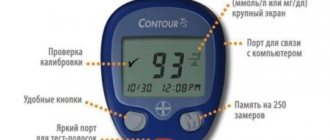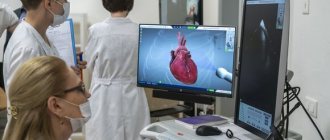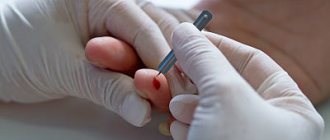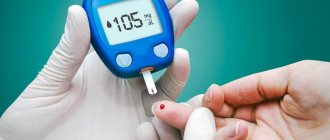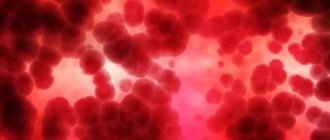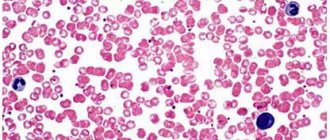Throughout the day, the level of glucose in the blood changes several times. The indicators are influenced by the qualitative and quantitative composition of food, physical activity, and neuropsychological state. The level of blood sugar after eating depends on the individual characteristics of carbohydrate metabolism. In older people, normative values shift upward due to an age-related decrease in cell sensitivity to insulin.
Some disturbances in the absorption of carbohydrates may occur in women during pregnancy and menopause. In a healthy person, ideal glucose levels after meals should not exceed 7.7 mmol/l (millimoles per liter - a unit of measurement of sugar). If the values are consistently elevated, diabetes mellitus or prediabetes is diagnosed. The prediabetic condition is characterized by the inability of body tissues to adequately absorb sugar, and glucose tolerance is impaired.
About glucose
Glucose is the main energy resource for the body and a source of nutrition for brain cells. Under the action of enzymes, food entering the intestines is broken down into individual components. Glucose molecules are formed from isolated saccharides and amino acids, most of which, after resorption (absorption) into the bloodstream, are transported to tissues and cells.
The role of the courier is played by the endocrine hormone of the pancreas - insulin. The liver converts the remaining unused sugar into glycogen (carbohydrate reserve). Whatever product the body processes, the level of glucose in the blood will increase. The degree of shift in sugar levels depends on the category of carbohydrates (simple or complex) present in the food eaten and the individual metabolic state of the person.
Objective data on glucose concentration (glycemia) can only be obtained by drawing blood on an empty stomach. In people with normal carbohydrate metabolism, the concentration of sugar in the blood relative to the internal environment of the body (homeostasis) remains at a stable level. When insulin sensitivity is impaired or insulin deficiency occurs, glucose accumulates in the blood, and cells and tissues remain “hungry.”
Reason for deviations up or down
Indicators may deviate from the norm due to disorders of the pancreas, sedentary lifestyle, severe stress, etc.
Nutritional factor
A nutritional factor is a violation of eating habits.
It consists of getting large amounts of sugar with food. Any food that contains excess carbohydrates is dangerous: baked goods, pasta, potatoes, etc. The strongest surges are provoked by foods with fast sugars. They are quickly absorbed, destabilize indicators, then are eliminated from the body or stored in reserves.
As a result of the rapid absorption of carbohydrates, a person soon feels hungry again. He may increase portions or eat more often. Along with carbohydrates, a person receives calories.
If more of them enter the body than the body needs, obesity develops.
Fat is deposited not only under the skin, but also on internal organs, which interferes with normal blood flow and metabolism. With junk food, cholesterol additionally enters the body, which binds to glucose and forms plaques that block the vascular lumen.
All these factors together worsen the functioning of the gastrointestinal tract and pancreas. With a high intake of carbohydrates, the body has to produce more insulin. The sensitivity of tissues to it decreases, and it becomes more difficult to transport sugar.
Indicator jumps occur more frequently. If a person does not revise his lifestyle in time, diabetes develops.
Eating junk food contributes to obesity.
Inflammation of the pancreas
The pancreas is responsible for producing insulin.
In any inflammatory disease that affects it, beta cells reduce the release of the hormone. Because of this, sugar is not transported to the organs and is not absorbed by them. As a result, an increase in glucose levels is observed against the background of cellular starvation. With a single acute inflammation, the indicators may deviate slightly, but the condition quickly normalizes. If the pathology becomes chronic, the concentration increases more strongly.
In some cases, with inflammation of the pancreas, the indicators do not change. This occurs when the pathology does not affect the islets of Langerhans.
The condition of the pancreas affects sugar levels.
Physical inactivity
With physical inactivity, metabolic disorders occur.
This is primarily due to low calorie expenditure. A sedentary lifestyle is often combined with obesity and low insulin sensitivity. Additionally, physical inactivity interferes with normal blood flow. Stagnation occurs, sugar is poorly transported to the organs and lingers in the bloodstream. If a person likes to snack on fatty foods, the situation gets worse: cholesterol plaques form on the walls of blood vessels.
Physical inactivity promotes blood stagnation.
Severe stress or pregnancy
With severe stress, hormonal balance changes.
The production of cortisol and adrenaline increases. This is a natural reaction of the body that is aimed at self-defense. At such moments, cells work for wear, providing maximum strength and dexterity to a person. Because of this, the heart rate increases and blood pressure increases. An additional portion of glucose enters the blood, which is needed as a source of energy for all organs.
During pregnancy, hormonal levels change. The body is rebuilt to bear a fetus. As the child grows, pressure on internal organs increases and blood circulation becomes difficult.
Blood glucose levels may remain elevated due to poor sugar transport and the need to provide the fetus with energy for nutrition and development. Hyperglycemia is common in pregnant women.
Hormonal levels change dramatically during pregnancy.
Diabetes
Diabetes mellitus develops either when there is insufficient insulin production or when the hormone functions are disrupted. The second is due to decreased susceptibility to it. As a result, sugar is transported but cannot enter the cell.
When hormone production is disrupted, a different situation occurs. Sugar is not carried by the bloodstream to organs and tissues.
Glucose remains in the bloodstream, which causes an increase in levels.
Additionally, due to cellular starvation, a request signal is received in the central nervous system, which provokes the release of reserve energy sources. Glycogen is broken down in the liver. This increases your sugar even more. Subsequently, its concentration drops sharply, which further worsens insulin sensitivity and the general condition of the patient.
Entering the body of a virus or infection
Normally, the presence of pathogens in the body does not cause changes in indicators. However, if you are predisposed to developing diabetes mellitus, hyperglycemia may occur due to infection. This is a protective reaction of the body that makes it easier to fight pathogens.
Sugar on an empty stomach
To determine glycemic values, capillary (from a finger) or venous blood is taken. In the second case, the figures may be slightly higher (within 12%). This is not a pathology. Before the study you must:
- Avoid drinking alcohol (three days before).
- Avoid food and oral hygiene in the morning (on the day of the test).
Important! If you prepare incorrectly on the eve of the analysis (sweets or alcohol for dinner, physical activity, nervous stress), the data may be distorted.
The results are assessed by comparing the obtained figures with standard values. Depending on the age category, the following fasting glucose levels are classified (in mmol/l):
| Children of preschool and school age | From puberty to 60 years | Elderly people up to 90 years old / 90+ |
| 3,3–5,6 | 4,1–5,9 | 4,6–6,4 / 4,6–6,7 |
For newborns and infants up to 3–4 weeks, the normative limits are 2.7 – 4.4 mmol/l. There are no differences in the laboratory examination results based on gender. With the exception of periods of changes in hormonal status in women (menopause, pregnancy). A prediabetic state is indicated by glycemic values on an empty stomach from 5.7 to 6.7 mmol/l.
In diabetics, glucose norms on an empty stomach are somewhat different, and determine the stage of the disease. Regulatory criteria for diabetic patients can be revised on an individual basis depending on the nature of the disease. You should not self-diagnose. To make a diagnosis of diabetes mellitus, it is necessary to undergo an extensive examination. A single discrepancy in sugar values does not 100% indicate the presence of pathology.
Indicators after meals
Laboratory diagnostics of blood for sugar immediately after eating is not carried out. To obtain objective results, biological fluid is collected at one-hour, two-hour and three-hour intervals after meals. This is due to the biological reactions of the body. Active production of insulin begins 10 minutes after food and drinks enter the gastrointestinal tract (gastrointestinal tract). Glycemia reaches its maximum limit an hour after food intake.
Results of up to 8.9 mmol/l after 1 hour correspond to normal carbohydrate metabolism in an adult. In a child, values can reach 8 mmol/l, which is also normal. Then the sugar curve gradually moves in the opposite direction. When measured again (after 2-2 hours), in a healthy body, glucose levels drop to 7.8 mmol/l and below. After passing the three-hour period, glucose values should return to normal.
Note: The female body absorbs food faster and releases glucose. The consumption of incoming energy occurs more rapidly than in men. This explains the fact that there are more women with a sweet tooth than lovers of sweets among the male half of the population.
The main time reference for diagnosing prediabetes and diabetes mellitus is 2 hours. Impaired glucose tolerance is recorded at values from 7.8 to 11 mmol/l. Higher rates indicate the presence of type 1 or type 2 diabetes. Comparative sugar levels (in mmol/l) in healthy people and diabetics (regardless of gender) are presented in the table.
| Absence of illness | 1 type | Type 2 | |
| on an empty stomach | 3,3–5,6 | 7,8–9 | 7,8–9 |
| an hour after eating | up to 8.9 | until 11 | until 9 |
| two hours later | up to 7 | to 10 | up to 8.7 |
| in 3 hours | up to 5.7 | until 9 | up to 7.5 |
To determine the borderline state of prediabetes and as part of the diagnosis of the true disease, a GTT (glucose tolerance test) is performed. Testing includes double blood sampling (on an empty stomach and after a glucose “load”). In laboratory conditions, the load is an aqueous solution of glucose in the ratio of 200 ml of water and 75 ml of glucose.
For diabetics, the level of sugar after meals depends on the stage of progression of the disease. In a state of compensation, indicators are close to healthy values. Subcompensation of the disease is characterized by certain deviations, since it becomes more difficult to normalize glycemia. In the stage of decompensation, it is almost impossible to bring the indicators back to normal.
HbA1C stands for glycated (glycated) hemoglobin. It is the result of the interaction between glucose and hemoglobin (the protein component of red blood cells). Inside erythrocytes (red cells), hemoglobin does not change throughout their life, which is 120 days. Thus, based on the indicators of glycated hemoglobin, the glucose concentration is determined in retrospect, that is, over the past 4 months. This analysis is extremely important for diabetics and the primary diagnosis of the disease. Based on its results, the state of carbohydrate metabolism in the body is assessed.
Average HbA1C according to the age category of patients
| Norm | Permissible deviations | Excess |
| up to 40 years old | ||
| <6.5 | 6.5–7.0 | >7.0 |
| 45+ | ||
| <7.0 | 7.0–7.5 | >7.5 |
| 65+ | ||
| <7.5 | 7.5–8.0 | >8.0 |
How many times the glycemic level can change per day depends on diet, physical activity, and the stability of the psycho-emotional state. An increase occurs after each meal, during irrationally planned sports training (or excessive stress during physical labor), and during nervous stress. The lowest rate is recorded during night sleep.
Symptoms of developing diabetes
In the initial stages of diabetes, the following symptoms are observed:
- Increased thirst. A person drinks more than 3-4 liters of liquid per day and cannot get enough. Because of thirst, he wakes up at night, and in the morning he feels a sore throat due to dry mucous membranes.
- Frequent urge to go to the toilet. The big one often walks like the little one. Because of this, the quality of sleep deteriorates: the bladder is disturbed even at night. Urine acquires a pungent odor reminiscent of acetone.
- Numbness in the limbs. A diabetic complains of unreasonable tingling in the tips of his fingers, palms and feet. This is due to disturbances in the functioning of the central nervous system and deterioration of blood circulation.
- Poor tissue regeneration. Abrasions and cuts take a long time to heal. They often become infected.
- Increased appetite. Due to sudden jumps in the amount of sugar, a person feels intense hunger, which is not true. It can occur, for example, 2 hours after a heavy lunch.
- General deterioration of condition. The patient has headaches. He suffers from lethargy and weakness. Performance deteriorates. The mood deteriorates for no reason.
If you skip meals, reduce portions, or go long periods between snacks, hypoglycemia may occur.
They are accompanied by panic attacks, severe weakness and the desire to quickly eat something. Trembling occurs in the hands and coordination of movements is impaired. In later stages, the patient's consciousness becomes confused and he may have little awareness of what is happening. In severe cases, this leads to coma.
Differences between hyperglycemia after meals and on an empty stomach
Hyperglycemia is a pathological condition of the body in which the glucose level systematically exceeds the norm. If sugar levels do not return to normal within the allotted three-hour interval, it is necessary to be diagnosed with diabetes mellitus or prediabetes. The development of diabetes is considered the main cause of hyperglycemia. Other factors that influence abnormal sugar levels before and after meals include:
- chronic pancreatitis;
- hidden oncological diseases;
- increased synthesis of thyroid hormones (hyperthyroidism);
- incorrect hormonal therapy;
- chronic alcoholism;
- hypertension and atherosclerosis;
- deficiency of macro- and microelements and vitamins in the body;
- systematic physical overload;
- abuse of monosaccharides and disaccharides (simple carbohydrates);
- constant psycho-emotional stress (distress).
In the absence of disease, the minimum values are 3.9 mmol/l, from 2 to 4 am
The main reason for a stable increase in blood sugar and the development of diabetes is obesity. The main symptoms that may indicate hyperglycemia are:
- physical weakness, decreased ability to work and tone, quickly onset fatigue;
- dysania (sleep disorder), nervousness;
- polydipsia (permanent feeling of thirst);
- pollakiuria (frequent urge to urinate);
- systematic headaches, unstable blood pressure (blood pressure);
- polyphagia (increased appetite);
- hyperhidrosis (increased sweating).
Due to the weak functioning of the immune system, acute respiratory viral infections and colds become more frequent.
Blood sugar and type of diabetes
However, it is impossible to determine the type of diabetes (first or second) by the sugar level. The type of disease is not related to the result of the analysis, but to the causes of the pathology:
- Type 1 diabetes is the most severe form, occurring in 10% of cases. It is an insulin-dependent pathology, when the main cause is associated with insufficient secretion of the hormone insulin. Treatment is lifelong injections of this substance with constant monitoring of sugar.
- Type 2 diabetes is a less severe form and occurs in 90% of cases. This is acquired non-insulin-dependent diabetes. It is due to the fact that cells perceive insulin worse, which is why glucose does not penetrate into them and remains in the blood, which leads to an increase in levels.
Both forms of the disease are fraught with danger to the health and even life of the patient. If you do nothing, your health will worsen, which may lead to adverse consequences:
- destruction of blood vessels;
- serious metabolic disorder (ketoacidosis);
- heart attack;
- stroke;
- problems with vision and hearing;
- coma;
- limb amputation;
- bacterial and fungal skin infections;
- impotence.
Hypoglycemia before and after meals
Hypoglycemia is a forced decrease in glucose levels below the critical level of 3.0 mmol/l. At values of 2.8 mmol/l, a person loses consciousness. The reasons for the body's abnormal reaction after eating are:
How to measure sugar
- Prolonged refusal to eat (fasting).
- Strong emotional shock, often of a negative nature (stress).
- The presence of a hormonally active pancreatic tumor that synthesizes insulin in excess (insulinoma).
- Physical activity that is disproportionate to the body’s capabilities.
- Decompensated stage of chronic pathologies of the liver and kidneys.
Sugar levels decrease due to excessive uncontrolled consumption of alcoholic beverages. Ethanol has the property of inhibiting (blocking) the processes of food processing, the formation of glucose and its absorption into the systemic bloodstream. However, a person under the influence of alcohol may not experience acute symptoms.
When diabetes mellitus is diagnosed, the listed reasons are supplemented by incorrect insulin therapy for the first type of disease (unauthorized increase in insulin doses or lack of food intake after the injection), exceeding the prescribed dose of glucose-lowering medications (Maninil, Glimepiride, Glirid, Diabeton) in the second type of pathology. The state of reactive hypoglycemia is life-threatening.
Signs of lack of sugar in the blood: polyphagia, unstable psycho-emotional state (unreasonable anxiety, inadequate reactions to what is happening), autonomic failures (decreased memory, concentration), impaired thermoregulation (constantly cold limbs), rapid, rhythmic contractions of muscle fibers of the legs and arms (trembling or tremors), increased heart rate.
Energy deficiency is primarily manifested by low performance and physical endurance.
The danger of significant deviations in sugar levels
Both high and low sugar levels pose a danger.
The latter is called hypoglycemia. With a sharp decrease in glucose concentration, glucose stops flowing to internal organs and cells, including the brain. This depresses the central nervous system. The brain stops transmitting and receiving impulses from internal organs. In a critical situation, this causes coma and death.
An increased concentration of sugar is called hyperglycemia. In this case, carbohydrates accumulate inside the blood plasma and in cells. Sugar begins to act as a toxin.
If there is a strong increase in the concentration of carbohydrates or the condition occurs frequently, the following complications appear:
- Lactic acid coma. Develops due to the accumulation of lactic acid in tissues. Accompanied by a decrease in blood pressure, a reduction in the volume of urine excreted and confusion.
- Ketoacidosis. Occurs due to an increase in the concentration of ketone bodies in tissues. This is a dangerous condition that threatens loss of consciousness and disruption of all body functions.
- Hyperosmolar coma. Develops against the background of dehydration of the body. Most often observed in patients over 65 years of age. In the absence of timely treatment, it leads to death.
Lactic acid coma is one of the complications.
Prevention of unstable glycemia in a healthy person
Normal blood sugar levels indicate the absence of carbohydrate metabolism disorders in the body. If the glucose level changes in one direction or another, you should resort to a number of preventive measures. This will help prevent (in some cases slow down) the development of pathological processes.
Preventive measures include:
- Changes in eating behavior. It is necessary to reconsider your diet and diet. Eliminate simple carbohydrates, fatty foods, fast food, and sweet carbonated drinks from the menu. Eat at least 5 times a day at equal intervals.
- Correction of physical activity. The load must correspond to physical capabilities. In addition, it is necessary to agree with your doctor which sports training is most suitable in each individual case (aerobic, interval, cardio, etc.).
- Refusal of drinking alcoholic beverages. The pancreas needs to be freed from alcohol load.
- Constant control over body weight (obesity leads to diabetes, anorexia can cause hypoglycemia).
- Regularly checking your sugar level (on an empty stomach and after meals).
- Strengthening the immune system. Hardening, systematic walks in the fresh air, course intake of vitamin and mineral complexes (before use, you must obtain consultation and approval from a doctor).
- Normalization of sleep. Night rest should be at least 7 hours (for an adult). You can eliminate dysania with the help of soothing decoctions and tinctures. If necessary, the doctor will prescribe medications.
Important! If you feel unwell, you should seek medical help. Simple fatigue can be a symptom of unstable glucose levels.



